2025-11-15 04:37:37
![]() See this visualization first on the Voronoi app.
See this visualization first on the Voronoi app.
This was originally posted on our Voronoi app. Download the app for free on iOS or Android and discover incredible data-driven charts from a variety of trusted sources.
How does the level of democracy in a country influence corruption?
According to new data from the Varieties of Democracy (V-Dem) project and a visualization by Our World in Data, the correlation is clear: democratic societies tend to be less corrupt.
The chart maps countries across two indices: Electoral Democracy (measuring free, fair, and meaningful elections) and the Political Corruption Index (focused on bribery and public theft), both scaled from 0 to 1.
Here is a full list of selected countries with their scores across both indices, based on the latest V-Dem data:
| Entity | Political Corruption Index (2024) | Electoral Democracy Index (2024) |
|---|---|---|
| Afghanistan | 0.67 | 0.08 |
| Albania | 0.63 | 0.51 |
| Algeria | 0.67 | 0.26 |
| Angola | 0.55 | 0.34 |
| Argentina | 0.39 | 0.71 |
| Armenia | 0.37 | 0.62 |
| Australia | 0.03 | 0.86 |
| Austria | 0.11 | 0.84 |
| Azerbaijan | 0.90 | 0.18 |
| Bahrain | 0.51 | 0.12 |
| Bangladesh | 0.91 | 0.20 |
| Barbados | 0.07 | 0.79 |
| Belarus | 0.42 | 0.16 |
| Belgium | 0.03 | 0.89 |
| Benin | 0.19 | 0.50 |
| Bhutan | 0.16 | 0.56 |
| Bolivia | 0.66 | 0.58 |
| Bosnia and Herzegovina | 0.76 | 0.51 |
| Botswana | 0.24 | 0.59 |
| Brazil | 0.44 | 0.80 |
| Bulgaria | 0.58 | 0.65 |
| Burkina Faso | 0.39 | 0.16 |
| Burundi | 0.78 | 0.18 |
| Cambodia | 0.90 | 0.19 |
| Cameroon | 0.93 | 0.29 |
| Canada | 0.03 | 0.84 |
| Cape Verde | 0.26 | 0.76 |
| Central African Republic | 0.85 | 0.30 |
| Chad | 0.95 | 0.20 |
| Chile | 0.08 | 0.84 |
| China | 0.55 | 0.07 |
| Colombia | 0.39 | 0.70 |
| Comoros | 0.84 | 0.28 |
| Congo | 0.83 | 0.25 |
| Costa Rica | 0.20 | 0.86 |
| Cote d'Ivoire | 0.62 | 0.43 |
| Croatia | 0.26 | 0.72 |
| Cuba | 0.59 | 0.18 |
| Cyprus | 0.16 | 0.77 |
| Czechia | 0.10 | 0.87 |
| Democratic Republic of Congo | 0.92 | 0.33 |
| Denmark | 0.00 | 0.92 |
| Djibouti | 0.68 | 0.25 |
| Dominican Republic | 0.71 | 0.71 |
| East Timor | 0.22 | 0.73 |
| Ecuador | 0.65 | 0.65 |
| Egypt | 0.73 | 0.19 |
| El Salvador | 0.68 | 0.34 |
| Equatorial Guinea | 0.84 | 0.18 |
| Eritrea | 0.74 | 0.07 |
| Estonia | 0.03 | 0.90 |
| Eswatini | 0.57 | 0.13 |
| Ethiopia | 0.55 | 0.26 |
| Fiji | 0.29 | 0.52 |
| Finland | 0.02 | 0.85 |
| France | 0.05 | 0.87 |
| Gabon | 0.72 | 0.23 |
| Gambia | 0.27 | 0.63 |
| Georgia | 0.19 | 0.48 |
| Germany | 0.02 | 0.84 |
| Ghana | 0.64 | 0.67 |
| Greece | 0.24 | 0.75 |
| Guatemala | 0.71 | 0.60 |
| Guinea | 0.86 | 0.16 |
| Guinea-Bissau | 0.81 | 0.28 |
| Guyana | 0.43 | 0.49 |
| Haiti | 0.77 | 0.22 |
| Honduras | 0.75 | 0.54 |
| Hong Kong | 0.08 | 0.17 |
| Hungary | 0.50 | 0.44 |
| Iceland | 0.02 | 0.84 |
| India | 0.67 | 0.40 |
| Indonesia | 0.76 | 0.48 |
| Iran | 0.78 | 0.17 |
| Iraq | 0.84 | 0.35 |
| Ireland | 0.03 | 0.90 |
| Israel | 0.12 | 0.72 |
| Italy | 0.20 | 0.80 |
| Jamaica | 0.18 | 0.80 |
| Japan | 0.06 | 0.82 |
| Jordan | 0.42 | 0.27 |
| Kazakhstan | 0.71 | 0.27 |
| Kenya | 0.54 | 0.55 |
| Kosovo | 0.27 | 0.65 |
| Kuwait | 0.31 | 0.29 |
| Kyrgyzstan | 0.80 | 0.33 |
| Laos | 0.74 | 0.13 |
| Latvia | 0.07 | 0.84 |
| Lebanon | 0.84 | 0.35 |
| Lesotho | 0.54 | 0.66 |
| Liberia | 0.88 | 0.61 |
| Libya | 0.82 | 0.20 |
| Lithuania | 0.17 | 0.80 |
| Luxembourg | 0.03 | 0.87 |
| Madagascar | 0.83 | 0.42 |
| Malawi | 0.72 | 0.58 |
| Malaysia | 0.32 | 0.52 |
| Maldives | 0.42 | 0.56 |
| Mali | 0.75 | 0.20 |
| Malta | 0.19 | 0.79 |
| Mauritania | 0.85 | 0.33 |
| Mauritius | 0.45 | 0.49 |
| Mexico | 0.56 | 0.51 |
| Moldova | 0.33 | 0.63 |
| Mongolia | 0.72 | 0.50 |
| Montenegro | 0.50 | 0.62 |
| Morocco | 0.64 | 0.26 |
| Mozambique | 0.73 | 0.30 |
| Myanmar | 0.83 | 0.08 |
| Namibia | 0.28 | 0.62 |
| Nepal | 0.62 | 0.67 |
| Netherlands | 0.02 | 0.82 |
| New Zealand | 0.01 | 0.86 |
| Nicaragua | 0.94 | 0.15 |
| Niger | 0.57 | 0.24 |
| Nigeria | 0.93 | 0.50 |
| North Korea | 0.68 | 0.08 |
| North Macedonia | 0.75 | 0.56 |
| Norway | 0.01 | 0.88 |
| Oman | 0.26 | 0.17 |
| Pakistan | 0.82 | 0.31 |
| Palestine/Gaza | 0.37 | 0.10 |
| Palestine/West Bank | 0.44 | 0.21 |
| Panama | 0.47 | 0.73 |
| Papua New Guinea | 0.72 | 0.46 |
| Paraguay | 0.80 | 0.58 |
| Peru | 0.66 | 0.63 |
| Philippines | 0.85 | 0.44 |
| Poland | 0.10 | 0.73 |
| Portugal | 0.16 | 0.83 |
| Qatar | 0.37 | 0.09 |
| Romania | 0.38 | 0.63 |
| Russia | 0.79 | 0.17 |
| Rwanda | 0.42 | 0.20 |
| Sao Tome and Principe | 0.28 | 0.67 |
| Saudi Arabia | 0.33 | 0.02 |
| Senegal | 0.30 | 0.62 |
| Serbia | 0.75 | 0.32 |
| Seychelles | 0.05 | 0.74 |
| Sierra Leone | 0.50 | 0.44 |
| Singapore | 0.03 | 0.41 |
| Slovakia | 0.28 | 0.75 |
| Slovenia | 0.06 | 0.72 |
| Solomon Islands | 0.60 | 0.67 |
| Somalia | 0.88 | 0.17 |
| Somaliland | 0.59 | 0.42 |
| South Africa | 0.56 | 0.73 |
| South Korea | 0.16 | 0.73 |
| South Sudan | 0.83 | 0.16 |
| Spain | 0.10 | 0.83 |
| Sri Lanka | 0.46 | 0.66 |
| Sudan | 0.80 | 0.14 |
| Suriname | 0.17 | 0.77 |
| Sweden | 0.01 | 0.88 |
| Switzerland | 0.02 | 0.89 |
| Syria | 0.74 | 0.15 |
| Taiwan | 0.23 | 0.80 |
| Tajikistan | 0.85 | 0.17 |
| Tanzania | 0.25 | 0.42 |
| Thailand | 0.66 | 0.39 |
| Togo | 0.76 | 0.36 |
| Trinidad and Tobago | 0.09 | 0.76 |
| Tunisia | 0.41 | 0.43 |
| Turkey | 0.82 | 0.29 |
| Turkmenistan | 0.89 | 0.15 |
| Uganda | 0.80 | 0.27 |
| Ukraine | 0.61 | 0.39 |
| United Arab Emirates | 0.11 | 0.10 |
| United Kingdom | 0.04 | 0.83 |
| United States | 0.05 | 0.84 |
| Uruguay | 0.05 | 0.85 |
| Uzbekistan | 0.83 | 0.22 |
| Vanuatu | 0.29 | 0.80 |
| Venezuela | 0.97 | 0.20 |
| Vietnam | 0.49 | 0.17 |
| Yemen | 0.91 | 0.13 |
| Zambia | 0.36 | 0.51 |
| Zimbabwe | 0.82 | 0.27 |
At a glance, Denmark stands out as the best performer, with near-perfect scores for democracy and minimal corruption.
Conversely, authoritarian regimes like Myanmar, Russia, and China have low democracy scores and relatively high corruption, though corruption levels vary even among less democratic states. Interestingly, no country appears in the upper-right quadrant, combining high democracy with high corruption, emphasizing the strong inverse relationship.
As outlined in V-Dem’s policy brief, democracies inherently support anti-corruption mechanisms. These include:
These structures make it harder for corrupt activities to go unnoticed or unpunished. In contrast, authoritarian systems often lack such safeguards, allowing corruption to flourish unchecked.
While this dataset relies on expert-based assessments, public perception also plays a role in understanding corruption. For more context, see our previous post on which countries are perceived as the most corrupt globally.
Explore more political data like this in our related post on The State of Democracy Around the World.
2025-11-15 02:22:56
![]() See this visualization first on the Voronoi app.
See this visualization first on the Voronoi app.
This was originally posted on our Voronoi app. Download the app for free on iOS or Android and discover incredible data-driven charts from a variety of trusted sources.
The U.S. labor market is evolving, and so are the pathways to high-paying careers. While a college degree has long been considered essential for financial success, new data from the Bureau of Labor Statistics shows that numerous careers offer six-figure salaries without requiring a four-year diploma.
The visualization above, by Julie Peasley, breaks down the top 20 highest paying jobs that don’t require a college degree, from nuclear reactor operators to transportation managers.
Here are the top 20 jobs by median salary:
| Rank | Occupation (U.S.) | Median Annual Wage (2024, USD) |
|---|---|---|
| 1 | Air Traffic Controller | $144,580 |
| 2 | Commercial Pilot (Non-Airline) | $122,670 |
| 3 | Nuclear Power Reactor Operator | $122,610 |
| 4 | Elevator and Escalator Installer and Repairer | $106,580 |
| 5 | First-Line Supervisor of Police and Detectives | $105,980 |
| 6 | Power Plant Distributor and Dispatcher | $103,600 |
| 7 | Transportation, Storage, and Distribution Manager | $102,010 |
| 8 | Power Plant Operator | $99,670 |
| 9 | Petroleum Pump System Operator, Refinery Operator, and Gauger | $97,540 |
| 10 | Detective and Criminal Investigator | $93,580 |
| 11 | Postmaster and Mail Superintendent | $92,730 |
| 12 | Electrical Power-Line Installer and Repairer | $92,560 |
| 13 | Farmer, Rancher, and Agricultural Manager | $87,980 |
| 14 | Transportation Inspector | $85,750 |
| 15 | Gambling Manager at Casino or Racetrack | $85,580 |
| 16 | Subway and Streetcar Operator | $84,830 |
| 17 | First-line Supervisor of Sales Workers (Non-retail) | $84,130 |
| 18 | Signal and Track Switch Repairer | $83,600 |
| 19 | Gas Plant Operator | $83,400 |
| 20 | Transit and Railroad Police | $82,320 |
Air traffic controllers ($144,580), commercial pilots ($122,670), and nuclear reactor operators ($122,610) take the top three spots, with many trade-heavy and supervisory roles also appearing above the $100,000 threshold.
A growing number of Americans are reconsidering the cost-benefit equation of college, especially as student debt burdens rise. Trade jobs are not only paying more, but also seeing increased interest from Gen Z workers looking for faster, debt-free entry into the workforce.
Many of these roles require certification, apprenticeships, or specialized training. For example, air traffic controllers must complete a rigorous FAA training program, but no degree is necessary. Similarly, commercial pilots flying non-airline routes, such as charter or medevac, often need licenses but not a bachelor’s degree.
What stands out in this ranking is the sheer number of high-paying skilled trades:
These careers offer strong wages without the need for a college degree, often relying on apprenticeships or vocational training instead.
Another key factor driving renewed interest in these careers is their reputation as being relatively “AI-proof.” Unlike many white-collar jobs facing disruption from artificial intelligence and automation, skilled trades typically require hands-on work in dynamic environments, making them less susceptible to technological replacement. For many young workers, this blend of job security and solid pay is an increasingly attractive proposition.
While these careers are exceptions to the rule, it’s still true that more education often leads to higher earnings on average. Our previous post, Charted: U.S. Salary by Education Level, shows how median income rises steadily with each level of formal education.
View the related post: How Much More Does a Graduate Degree Earn by State?
2025-11-15 01:36:34
View the full-size version of this graphic
Workers are navigating tight budgets as everyday costs climb. Tools that bridge timing gaps now shape whether people fall behind or finally catch their breath.
Created in partnership with Payactiv, this graphic contrasts employer-integrated access to already-earned pay with direct-to-consumer estimated advances, showing how verification, repayment, and employer involvement drive different outcomes for workers and organizations.
Employer-sponsored Earned Wage Access (EWA) connects directly to employee Time & Attendance and payroll systems. Employees can securely unlock wages they’ve already earned, not guesses about future income. Because access is based on employer-verified hours, amounts are precise, predictable, and aligned with actual pay.
Repayment is simple: on the regular pay cycle, the employer settles with the provider, so workers aren’t stuck repaying a lender or juggling collections. When properly structured, this model is often treated as non-credit because it’s access, not an advance.
Over time, this model helps workers transition from crisis management to stability, supporting savings habits, dignity, and reducing day-to-day financial stress.
This model is also very in demand. In Visa’s Earned Wage Access Insights Report, 95% of employees say they’d be interested in working for an employer who offers Earned Wage Access.
Estimated wage advance apps target workers directly, bypassing employer payroll. Instead of verified hours, they rely on projected earnings, which can misalign with reality if shifts change, hours drop, or income varies.
Repayment typically pulls from a worker’s own bank account and involves “instant transfer” fees, tips, and credit-like charges, or paycheck reroutes. As these costs and shortfalls accumulate, they can create debt spirals, anxiety, broken autopay, and bank switching—shifting risk back onto people who can least afford it.
The real difference isn’t just speed. It’s who is in the partnership, how pay is verified, and how repayment flows.
Employer-integrated EWA provides workers with a safer way to access their earned wages, while direct-to-consumer estimated advances create a two-way relationship that resembles debt.
Demand for responsible EWA is strong, and employers that offer integrated access often see higher morale, better retention, and lower turnover costs—sometimes in the millions.
If it’s earned, it’s access. If it’s estimated, it’s an advance.
Earned Wage Access reinforces the worker–employer relationship while supporting long-term stability, and workers are asking for it.

Find out more in Payactiv’s EWA Blueprint

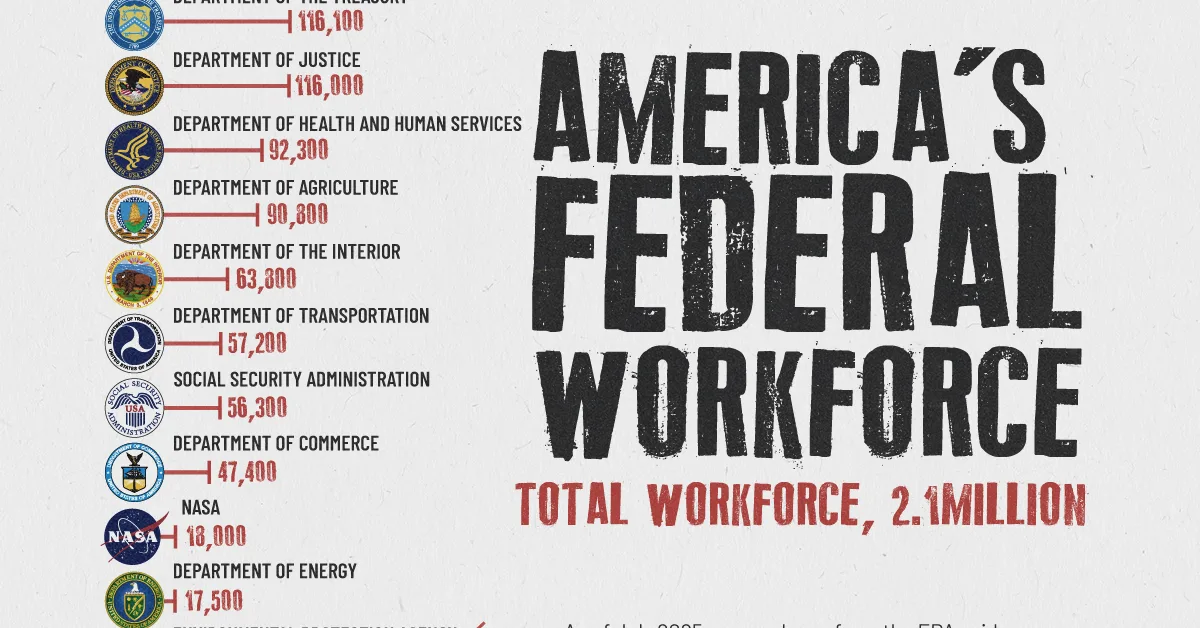
We break down America’s 2.1 million federal workers by agency, revealing the massive scale of defense and veterans’ services.
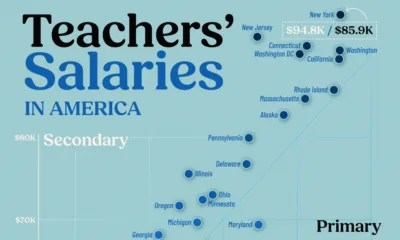

We visualized average teacher salaries by state, showing how pay ranges from under $50,000 to over $90,000.
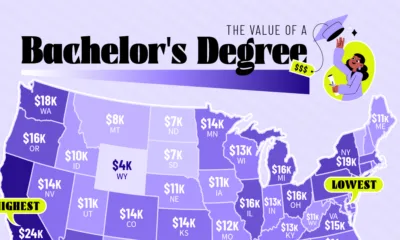

The added value of a bachelor’s degree ranges from $3,000 to nearly $24,000 across the United States.
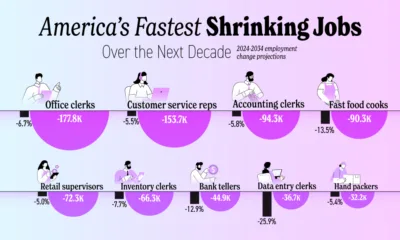

As artificial intelligence and automation reshapes the workforce, we identify the fastest shrinking jobs in America over the next decade.
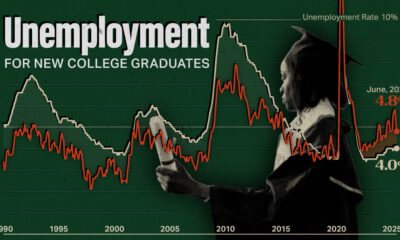

New graduate unemployment has been steadily rising above the overall U.S. unemployment rate, reversing a trend of more than two decades.
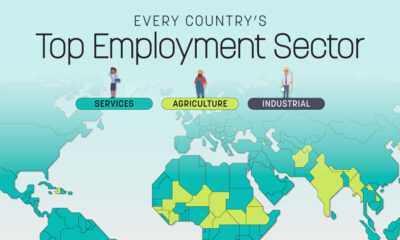

Using World Bank data, this map shows the top employment sector by country: services in rich nations, agriculture in poorer ones.
2025-11-14 23:11:49
See visuals like this from many other data creators on our Voronoi app. Download it for free on iOS or Android and discover incredible data-driven charts from a variety of trusted sources.
As the most visited website in America, Google’s traffic climbed over 3% month-over-month, reaching 16.2 billion visits in July.
Google continues to dominate the digital landscape—alongside major tech players like Meta’s Facebook and Amazon. Meanwhile, even with its rapid adoption, ChatGPT still trails more established sites such as Reddit, Bing, and Yahoo.
This graphic shows the most visited websites in the U.S. as of July 2025, based on data from Similarweb.
Here are America’s top 20 most frequently visited websites:
| Ranking | Domain | Monthly Visits July 2025 |
|---|---|---|
| 1 | 16.2B | |
| 2 | YouTube | 5.7B |
| 3 | 2.6B | |
| 4 | Amazon | 2.5B |
| 5 | 2B | |
| 6 | Bing | 1.6B |
| 7 | Yahoo | 1.6B |
| 8 | 1.1B | |
| 9 | X | 1B |
| 10 | ChatGPT | 864M |
| 11 | Wikipedia | 715M |
| 12 | 567M | |
| 13 | eBay | 520M |
| 14 | Walmart | 493M |
| 15 | New York Times | 462M |
| 16 | The Weather Channel | 447M |
| 17 | TikTok | 444M |
| 18 | Microsoft 365 (office.com) | 426M |
| 19 | Fandom | 381M |
| 20 | United States Postal Service | 360M |
Today, the big story is ChatGPT’s phenomenal rise—now ranking as the 10th-most visited website overall.
Globally, 30% of ChatGPT queries are for work-related tasks, highlighting both its expanding role in the workplace and the chatbot’s widening international presence. In fact, it stands as the fourth most-visited website in India.
Meanwhile, the New York Times (#15) saw their month-over-month traffic decline 2.6%. In fact, it was the only domain across the top 20 to see traffic fall. AI search overviews and shifting search patterns, in particular, may be driving these declines.
By contrast, The Weather Network (#16) saw the fastest monthly traffic growth of 20.1%, as extreme heat and severe storms hit the country. It was followed by Amazon, with 9.7% growth, and ChatGPT, with a 8.9% increase.
To learn more about this topic, check out this graphic on the top domains cited by artificial intelligence.
2025-11-14 20:55:46
See visuals like this from many other data creators on our Voronoi app. Download it for free on iOS or Android and discover incredible data-driven charts from a variety of trusted sources.
Since 2020, U.S. GDP per capita has grown by $25,081, the seventh-highest increase in the world.
Robust financial markets and economic resilience have supported the economy, even as inflation strained consumer wallets. Outside of America, there have been similar success stories, with some countries even doubling their GDP per capita in that relatively short span of time.
This graphic shows countries with the biggest gains in wealth growth since 2020, based on data from the IMF’s latest World Economic Outlook.
Here are the top 20 countries by GDP per capita growth in the past five years, in nominal terms based on U.S. dollars:
| Rank | Country | GDP per Capita Dollar Increase 2020-2025 |
Rank | Country | GDP per Capita % Increase 2020-2025 |
|---|---|---|---|---|---|
| 1 |
 Liechtenstein Liechtenstein |
$67,713 | 1 |
 Guyana Guyana |
351% |
| 2 |
 Ireland Ireland |
$42,914 | 2 |
 Georgia Georgia |
135% |
| 3 |
 Macao Macao |
$37,820 | 3 |
 Kyrgyz Republic Kyrgyz Republic |
119% |
| 4 |
 Iceland Iceland |
$35,912 | 4 |
 Armenia Armenia |
110% |
| 5 |
 Singapore Singapore |
$33,071 | 5 |
 Türkiye Türkiye |
108% |
| 6 |
 Luxembourg Luxembourg |
$29,248 | 6 |
 Albania Albania |
106% |
| 7 |
 U.S. U.S. |
$25,081 | 7 |
 Venezuela Venezuela |
102% |
| 8 |
 Switzerland Switzerland |
$24,911 | 8 |
 Macao Macao |
102% |
| 9 |
 Guyana Guyana |
$24,425 | 9 |
 Bulgaria Bulgaria |
100% |
| 10 |
 Norway Norway |
$23,608 | 10 |
 Haiti Haiti |
99% |
| 11 |
 Qatar Qatar |
$20,479 | 11 |
 Montenegro Montenegro |
99% |
| 12 |
 Netherlands Netherlands |
$19,644 | 12 |
 Burundi Burundi |
98% |
| 13 |
 San Marino San Marino |
$19,628 | 13 |
 Tajikistan Tajikistan |
92% |
| 14 |
 Malta Malta |
$17,440 | 14 |
 Maldives Maldives |
91% |
| 15 |
 Aruba Aruba |
$17,091 | 15 |
 Serbia Serbia |
89% |
| 16 |
 UK UK |
$16,430 | 16 |
 Moldova Moldova |
89% |
| 17 |
 Denmark Denmark |
$15,505 | 17 |
 Uzbekistan Uzbekistan |
86% |
| 18 |
 Israel Israel |
$15,414 | 18 |
 São Tomé and São Tomé andPríncipe |
86% |
| 19 |
 Belgium Belgium |
$14,484 | 19 |
 Croatia Croatia |
82% |
| 20 |
 Cyprus Cyprus |
$14,117 | 20 |
 Poland Poland |
78% |
Liechtenstein soars above the rest, with GDP per capita rising $67,713 since 2020.
Underscoring this jump is the fact that its currency is tied to the Swiss franc, which rose 20% against the U.S. dollar over the period. At the same time, the country stands as a hub for advanced, competitive manufacturing. The country also has many working commuters from neighboring nations, and this helps up drive up domestic wealth measures like GDP per capita.
Ireland ranks in second, with a $42,914 jump in GDP per capita. Several Big Tech and pharmaceutical companies are headquartered in the country, further driving up the nation’s wealth.
If we look at GDP per capita in terms of percentage gains, Guyana is a clear global outlier. Since 2020, GDP per capita has skyrocketed 351%. Guyana’s 11 billion barrel oil discovery is one of the world’s largest in decades, significantly fueling GDP growth.
Meanwhile, several countries across Eastern Europe and Asia have witnessed the sharpest gains in GDP per capita globally, with Georgia, Kyrgz Republic, Armenia, and Türkiye standing in the top five.
To learn more about this topic, check out this graphic on the world’s richest countries in 2025.
2025-11-14 19:06:00
As global electrification ramps up, electricity demand in major economies is expected to rise, driving a corresponding increase in demand for copper, the metal that powers the modern energy grid.
This graphic, sponsored by BHP, utilizes data from Ember, the World Bank, and the Lowy Institute to visualize the projected growth in electricity consumption and GDP per capita across five major economies between 2024 and 2035.
Estimates of each country’s electricity consumption in 2024 were released in 2025, whereas projections for 2035 consumption were formed back in 2021.
Together, these five economies are projected to increase their electricity consumption by 500 terawatt hours (TWh) by 2035.
| Country | 2024 TWh | 2035 TWh | Projected Change in GDP Per Capita |
|---|---|---|---|
 China China |
10,059 | 9,956 | 31.2% |
 U.S. U.S. |
4,401 | 4,401 | 11.0% |
 India India |
2,055 | 2,385 | 52.1% |
 Japan Japan |
1,022 | 954 | 15.3% |
 Indonesia Indonesia |
373 | 711 | 47.7% |
Growth in GDP per capita is one of the most significant contributors to the projected increase in electricity consumption. As economies grow, inhabitants gain the ability to purchase technologies that consume more electricity.
Copper’s exceptional conductivity makes it indispensable across the power system, from high-voltage transmission lines to home wiring and electric vehicles. It’s the backbone of moving electricity.
As countries expand their grids and scale clean energy, copper demand is set to rise sharply.
Renewables such as wind and solar can use up to 5x more copper than conventional generation, and electric vehicles use up to 4x more than internal-combustion models.

Get more insights from a World Leading Copper Producer Subscribe Here


Projected electricity usage growth in major economies is driving global copper demand—see how energy use is rising from 2023 to 2035.
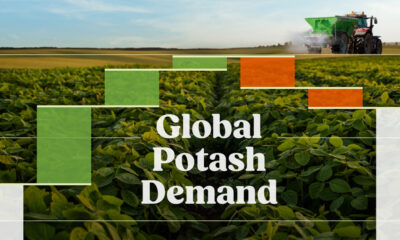

Global potash demand is projected to rise 65% by 2050. See what’s driving the surge and why potash is key to global food security.


Since 1960, potash demand has outpaced both population growth and crop production.
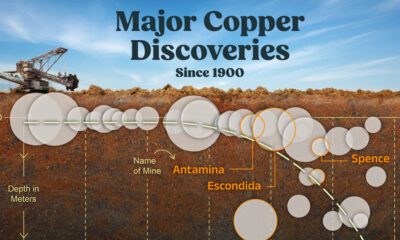

Copper discoveries are becoming increasingly rare and often found deeper underground.


Copper demand globally is estimated to rise by 70% from 2021 to 2050. What are the main sources of this increase in demand?


China’s steel demand remains robust, but the breakdown on a sectoral level has shifted since 2010. Which sectors are driving steel consumption?